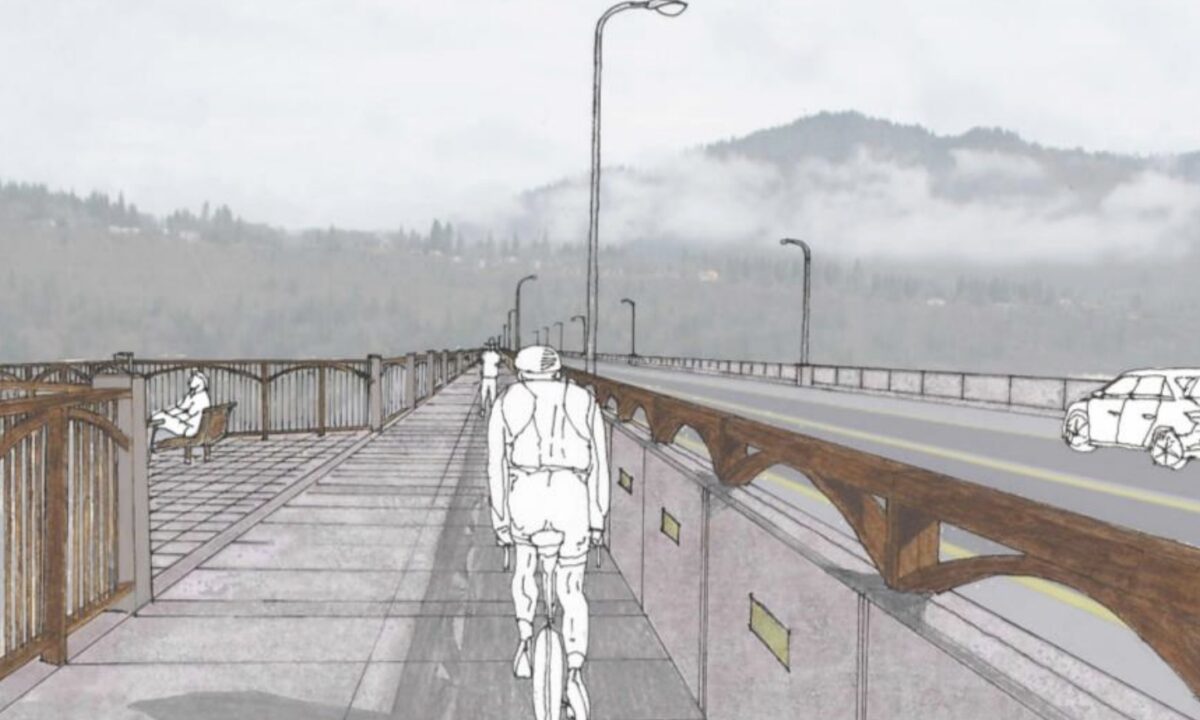
The Hood River-White Salmon Bridge is beautiful and connects towns, many destinations, and excellent cycling opportunities. Unfortunately bicycling over it is prohibited which means there’s no way to legally and safely pedal across the Columbia River for 40 miles between Cascade Locks and The Dalles. But a project to replace the bridge is reason for optimism that a bikeway could finally be on the horizon.
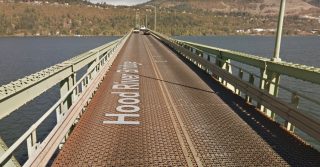
Even if you flaunted the law and tried to sneak over the bridge today, you might regret it. It’d be harrowing. There’s no pavement, just spiked steel that you can see through to the Columbia River below. And with a roadway deck of just 18 feet 9 inches for two lanes of traffic, bicycle riders would have to to share the space with impatient drivers for a full mile before reaching the other side. A new bridge with bike lanes would be a game-changer.
Currently in the planning stages, the Port of Hood River has just released the Supplemental Draft Environmental Impact Statement (EIS) for public review and comment. This is a federally mandated document that will get the Port one step closer to final environmental review by the end of next year. After that, they’ll be cleared for full engineering, design and construction.
Advertisement
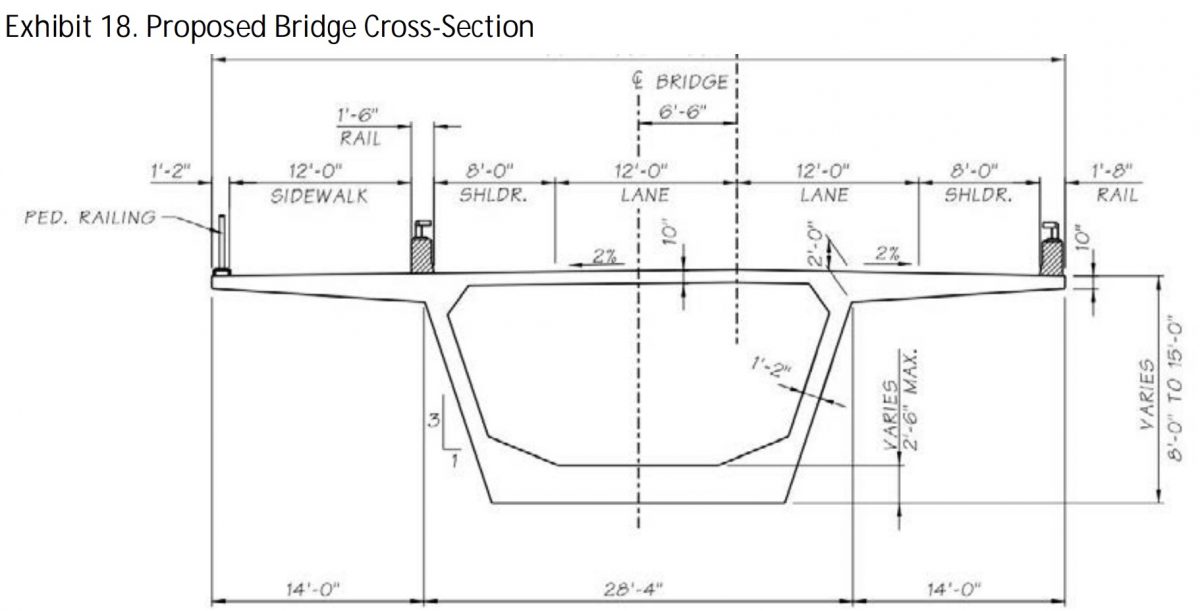
According to retired Portland optometrist and former Chair of the Oregon Bicycle and Pedestrian Advisory Committee Armando “Jerry” Zelada, the plans for the bridge are good news for bicycle riders; but could be better. He points to the EIS which spells out that current plans for the new bridge include, “a wider two-lane facility built to standards including 12-foot lanes plus shoulders. The new bridge will also provide accommodation for pedestrian and bicycle users.”
The Hood River-White Salmon Bridge Replacement Project Final Transportation Technical Report released on November 30th includes more details:
The project roadway would consist of two 12-foot travel lanes, two 8-foot shoulders, and one 12-foot transportation facility for shared use (pedestrian and bicycle) travel on one side. The 12-foot shared use facility would be located on the west side of the bridge, with a physical barrier separating motor vehicle traffic from people walking or riding bikes. The shared use path would provide a transportation facility that connects to existing and planned sidewalks, bike lanes, and trails on either end of the bridge. The posted speed limit on the bridge is expected to be 35 mph.
While having any dedicated space for cycling feels like a big improvement, Zelada, who organized the Gorge Pedal ride last summer, is worried that the proposed bike facilities on the new bridge might not be enough. Zelada says this bridge could see a huge influx of bicycle riders.
Advertisement

“We need cyclists to voice their support for larger bike lanes and larger pedestrian lanes.”
— Armando Zelada
“When you look at other trails like the Historic Columbia River Highway Trail and the carfree Hatfield Trail (east of Hood River), one sees the limits of width conflicting with the increased popularity,” Zelada shared with us in an email. “We need cyclists to voice their support for larger bike lanes and larger pedestrian lanes… I might even suggest lanes on each side of the bridge!” he added.
The Oregon Department of Transportation plans to finish work on the Mitchell Point tunnel segment of the Historic Columbia River Highway by 2023, leaving a scant 1.6 miles left to fulfill the vision of a safe I-84 alternative for cycling between Troutdale and The Dalles. This will increase cycling in the Gorge even more, putting pressure on other bikeways in the area.
If you’d like to voice support for cycling space on this new bridge, you can leave a comment via the online survey through January 4th.
— Jonathan Maus: (503) 706-8804, @jonathan_maus on Twitter and jonathan@bikeportland.org
— Get our headlines delivered to your inbox.
— Support this independent community media outlet with a one-time contribution or monthly subscription.


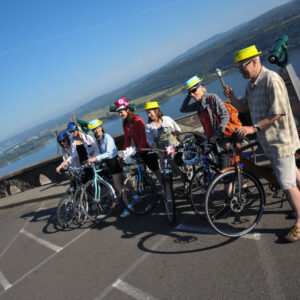
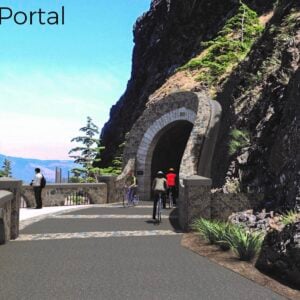
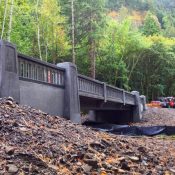
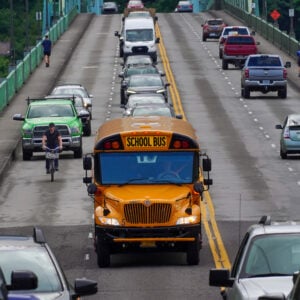
Thanks for reading.
BikePortland has served this community with independent community journalism since 2005. We rely on subscriptions from readers like you to survive. Your financial support is vital in keeping this valuable resource alive and well.
Please subscribe today to strengthen and expand our work.
Stoked to catch the 4:45pm train to Bingen and ride across just in time for dinner at Pfriem!
Does the Empire Builder allow roll-on bikes in the baggage car?
Good point, I’m not 100% certain, but I think the Empire Builder would require you to box your bike.
Amtrak does require you to box the bike from Portland through Spokane and points beyond, for the simple reason that there is no baggage car on that train portion (nor a diner), so all the baggage goes into one of the lower coach spaces set up for it on the double-decker train. (There is a baggage car on the Seattle portion that does allow for roll-on bikes, plus the diner.) I’m not sure if they even allow bikes to be delivered to the stations in between that don’t have checked baggage service (most smaller stations do not). On the plus side, the Amtrak boxes are huge – only the pedals need removing and the handlebars turned sideways – in most cases you can leave on both wheels and the saddle. The box plus fees are usually $20 total.
Boxes are not required on the train to Seattle, or the gorge, although you do need to reserve a spot with your ticket. There is a baggage car. They might require you to take off bags. The fee is between $5-20 depending on distance I believe. Most trains now have baggage or roll on. My dream is that they will install hangers like most commuter trains.
https://www.amtrak.com/bring-your-bicycle-onboard
From the Amtrak bike FAQs:
“How do I know if my train or station offers bicycle service?
Enter your origin and destination in the Fare Finder (for example, Los Angeles to Seattle). If bike service is available, an icon with a number of spaces available will display. Select your desired journey option and proceed to the ‘Add Ons’ step to add bikes to your reservation.”
“Are there any routes where I still have to box my bicycle?
The only route where passengers are required to check their bicycle in a box is the Portland to Spokane portion of the Empire Builder. This train splits at Spokane and the baggage car travels to/from Seattle. We are working to expand carry-on service to the Empire Builder route to alleviate this restriction.”
This is true on Cascades and the Coast Starlight, but is not true for our “Baby Builder” between Spokane and Portland. The train splits in Spokane, and Portland gets the observation car, a sleeper, and usually 2 coach cars. The remaining sleepers, coach cars, diner car, and baggage car goes to Seattle.
When we took the Builder to Essex, MT last year, we had to throw our skis in an empty room on the lower level of the sleeper.
Hmm, well maybe this will be fixed by the time this bridge gets built. Otherwise, maybe a good reason to invest in a Brompton!
I’ve always been surprised that they don’t add a baggage car onto the back of the Empire Builder, so the Portland leg can have baggage service. It might present issues east of Spokane, were conductors would have to open both baggage cars (on opposite ends of the long train) to retrieve baggage.
They do have baggage service, they just use coach cars that have a baggage area in the lower level (instead of seating) vs. a dedicated car.
If they don’t get a ton of Portland baggage, they could maybe put bike hooks in the baggage compartment they use now. It’s actually easier to access because it’s at a lower level than the regular baggage cars.
I took the Empire Builder nearly annually from 1986 through 2015 and I vaguely remember that there used to be a baggage car hooked up to the Portland to Spokane train, but it got eliminated during a major budget cut in the mid-90s. When there was a 2nd baggage car, Amtrak would move it and the sleeper to join the Seattle baggage car and two sleepers during the 2 am switching in Spokane.
I took the Coast Starlight train from Seattle to Portland this year with a regular bike and I didn’t need to box it.
Yes, nearly all Amtrak routes nationally no longer require bike boxes unless there are too many bikes wanting space, which is very rare. Most trains have hooks. All except one route…
Can bikes not use the 8 foot shoulders? I mean you could haul a manufactured dwelling over that bridge and have room to pass a cyclist in the shoulder. Short of that 12 foot seems adequate for the amount of pedestrian and bike traffic that the bridge would likely see. Seems like a good balance to minimize the carbon footprint some.
AFAIK bike riders would be allowed in the shoulders… Unless someone tried to say that Oregon’s mandatory sidepath law (which says if a bike path is present you must use it) would prohibit it and mandate that folks use the path… But that law is so rarely enforced that it is hardly relevant.
Since the bridge crosses into Washington, wouldn’t its use be governed by both states or by federal (interstate) law, as along other major rivers like the Mississippi and Ohio?
I kind of wonder now if a 16 foot stripped path with reducing the shoulders to 6 feet wouldn’t make more sense, it’d be the same footprint. At that point you could require cyclists take the path. 12 foot lane plus 6 foot shoulder would still handle all over dimensional truck loads.
12-foot lanes and 8-foot shoulders with a 35-mph speed limit? US highway design never ceases to amaze me. Why not design the roadway so 35 mph will feel like a comfortable driving speed?
This bridge sees a lot of truck traffic, so I think 12-foot lanes are justified. Other traffic-calming features like chicanes or speeds bumps would be impractical and expensive. The reality is that people will likely go more like 50mph on the bridge, but with a 12ft protected MUP, that shouldn’t be an issue.
I am quite happy with a one side bike/pedestrian solution.
Two small paths like St. Johns Bridge is awful. A center solution like 205 is even more awful. While sure a 16′ wide would be even better, unless there is an Oregon City style elevator hidden in the works I don’t think this bridge will see commuter-level use as there is quite a steep bluff to White Salmon**. So I’m quite happy to take a 12 footer to the bank and give a kudos to the engineers for proposing a useful solution.
Am I getting something wrong? This seems like an appropriate solution to the very inappropriate current lack of facilities?
** Just for fun I looked at RWGPS from the bridge to Everybody’s Brewing. If you take the main route (141) is 506′ with a max grade of 11.3%. Just for context the OC elevator goes up ~100′. Tabor from 60th to the top is ~300′.
Considering the sidewalks on the SJB are probably less than 5 feet combined, 12 feet is going to feel like luxury
I agree it’s probably ample space for the traffic it will see. My concern would be space for sight-seeing. I imagine it will be quite a popular place to take a stroll and gaze for awhile. Bump-outs like on the Sellwood would make a lot of sense.
It appears from the image at the top of the page that the design does include bump-outs, which are nice. That said, since it will be more than twice the length of Sellwood or St. Johns, I doubt there will be much pedestrian use beyond sightseers at each end.
It does seem like they could stripe it similar to Sellwood Bridge…the shoulders get marked as bike lanes for the “stronger, confident” cyclist, and the 12’shared use path is for walkers, runners, and less confident people on bikes.
As an aside, it seems that people on foot forget that the Sellwood Bridge “sidewalk” is a shared use path (why the pavement is scored two different ways…). Several recent crossings on foot and bike, I’ve witnessed walkers cussing at families on bikes riding on the “sidewalk” and one walker tried to push a guy on an electric wheel board off the path and onto the bike lane.
I’ve witnessed this same behavior – some guy yelled at my wife who had our toddler along in the bike seat as we pedaled at a leisurely pace across the bridge. Sheesh. Maybe time to apply some of those thermoplastic bike/ped stencils?
That’s ridiculous. I am a confident rider and I always take the sidewalk simply for the views.
I’m a highly experienced and confident rider, and I almost always take the Sellwood sidewalk, because why be next to cars when it’s not necessary? The other day I got yelled at and almost had a physical altercation with a guy cursing at me for being on the left side of the sidewalk. Made me think there needs to be a more concrete indication of multi-use (like bike symbols) on the sidewalk.
In 1995 I crossed the Lions Gate Bridge into Vancouver BC on a narrow sidewalk made up of spiked steel – very high, very scary, never again.
I biked that bridge in 2008 and don’t remember anything funky; I think they might have covered the steel with something friendlier.
Glad to hear it!
I disagree that it’s ugly. Simple, sleek, flat. Doesn’t detract from the surroundings; which are now half urban anyway. Looks like a good future bridge
Hard to argue values, but if not outright ugly, the proposed bridge is inappropriate for a national scenic area. The bridge looks like an industrial feature taken out of a freeway bridge catalog. The location is visible for miles in every direction and putting an underwhelming design there does not minimize the impact. It only disrespects the Gorge by not bothering to consider aesthetics. No design would be unobtrusive but a design that acknowledges that it has visual impact and that has grace in design would embrace the truth of its strong visual presence
One thing I hope to experience on the new Cuomo bridge is the sound barrier plexiglass. A physical barrier is necessary, but a sound barrier is something that makes a bridge, so I’ve heard, actually pleasant despite the raucous metal beasts a mere few feet away.
Wow, the Durisol system with clear panels between bikes/peds and traffic looks great!
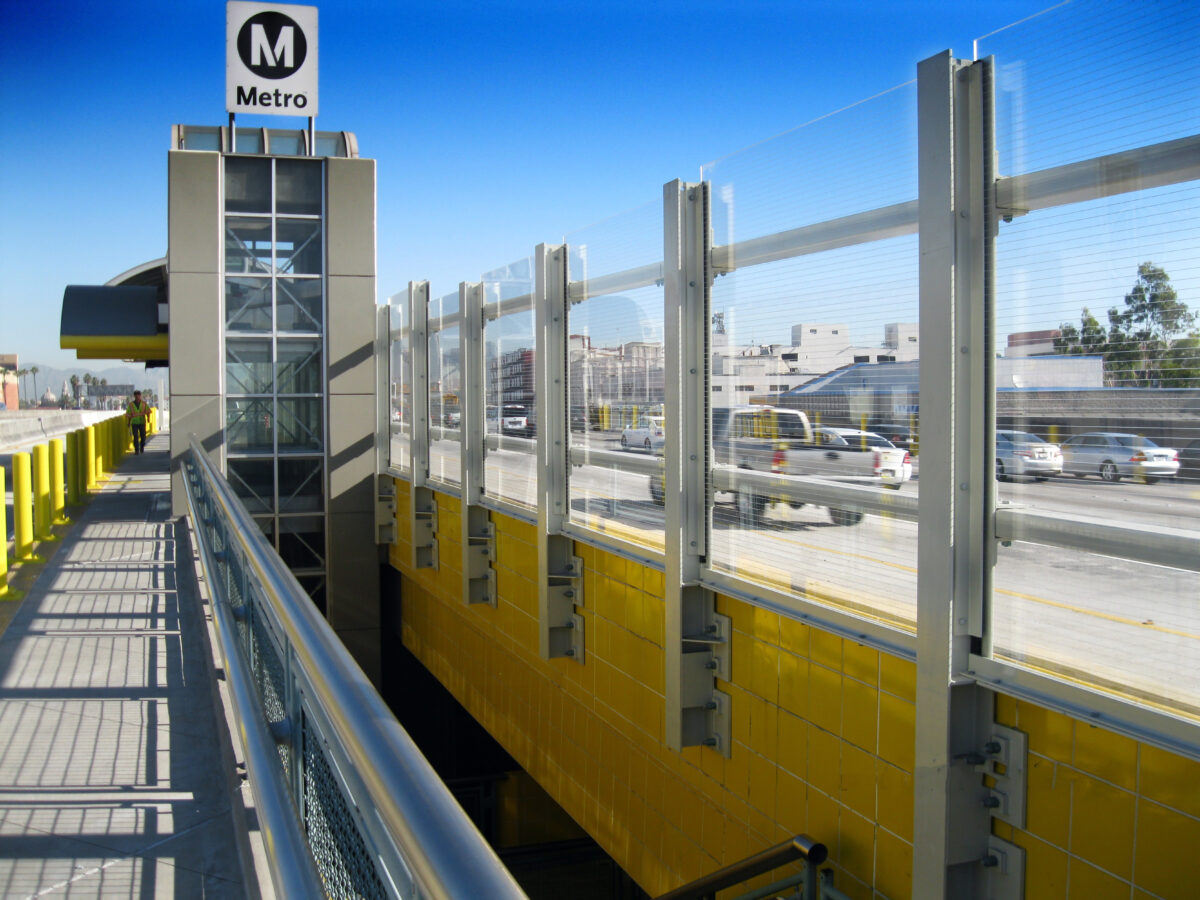
Yeah, it’s a great idea. Port of HR?
This would also help a lot with cross-winds, which will most definitely be an issue on this bridge.
One thing I appreciate with the drawings is that they show exactly the information people need to judge the design. The cross-section shows the important dimensions. The rendering shows the view from exactly the eye-level and location someone riding across it would have. The photo/rendering shows how it would look from an actual, typical location a human–not a bird–would see it from.
Some other, recent bridge projects–say the new Burnside Bridge–must have had rendering budgets 100x larger than this one, but for all their impressive videos, aerial fly-bys, etc. they didn’t include any views taken from locations and eye levels that any actual user would have.
I don’t have strong feelings about the design (wider paths are always better, and the appearance seems utilitarian but fine) but I’m confident in my impressions because the images give me the important info, instead of leaving me guessing.
A wider bike path would better serve the many rides, runs and community events this new path will attract.
The “bike” lanes need to be solely on a very wide sidewalk. A wide “shoulder” just encourages people to drive cars and ride motorcycles at very high speeds on a new bridge.
Citizens flout the law. Only government can flaunt the law.
I’m going to flout your flaunt.
Zelada probably has a good point–this bridge will likely induce demand from bike riders, especially after the historic highway is finished. I’m also glad to see there is physical separation from motor vehicles. My guess is that the 35mph speed limit will be widely ignored given the wide lanes and shoulders. Wouldn’t surprise me at all if this bridge turned out to be more dangerous for people in cars than the existing one, given the likelihood of increased speeds.
It’s a little odd that the shoulder is less than the width of a max width vehicle (96 inches plus mirrors and you have to open the door). Then with all the dodads that they will no doubt add onto the bridge, the walkway/rideway will be less than 12 feet.
But 12 feet is fine. It’s the standard width of shared use paths around the country.
10+ years ago, I remember pulling up to the bridge on the Oregon side on a ride that we had planned to end at Walking Man. We got turned away by the toll attendants, and were stymied until someone graciously offered us a ride across in the bed of their pickup truck. I was grateful to get that ride, but I think having a bike lane on the bridge will be even better 🙂
I’m gonna look on the bright side and say I’d be thrilled with a 12′ wide 2-way lane on the west side. Compared to what we have now it’s a huge improvement. I’m no fan of the 205 bike lane, having commuted on it daily for a year, but I’ll bet it’s not 12′ wide, and it runs u the middle with 4 freeway lanes on each side. I also think projecting traffic similar to what the paths on the Oregon side of the gorge get is overly optimistic. What are casual cyclist going to cross to Washington to do, ride east or west on the dangerous shoulder of HWY 14? That’s only going to attract experienced cyclists or fools.
I pulled a tape on the I-205 path back when someone tried to drive over it. It’s barely 8 feet. I think you’re right that 12’ will be fine.